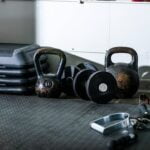Staying fit and healthy is a goal many of us strive for, but what happens when we’re unable to exercise? Whether due to injury, illness, or other limitations, finding alternative ways to stay active and maintain overall health becomes crucial.
In this article, we will explore the challenge of staying fit when you can’t exercise and the importance of finding alternative ways to support your physical well-being. From nutrition and stretching to mindfulness and sleep, there are various strategies that can help you stay healthy and active even without regular exercise.
When faced with the inability to engage in traditional forms of exercise, it’s essential to shift focus towards other aspects of health and fitness. Nutrition plays a critical role in supporting overall well-being, making mindful food choices can help maintain a healthy diet and support fitness goals.
Additionally, incorporating stretching exercises, breathing techniques, resistance training, mindfulness practices, alternative movement forms such as yoga or tai chi, and prioritizing quality sleep can all contribute to maintaining health and vitality in the absence of regular exercise.
In the following sections, we will delve into specific strategies for maintaining health without relying on intense physical activity. By exploring these alternative approaches to staying fit when unable to exercise, you can continue on your journey towards better health and wellness.
Nutrition
Maintaining a healthy diet is essential for overall health and fitness, especially when unable to engage in regular exercise. While physical activity plays a significant role in supporting a healthy lifestyle, nutrition is equally important for maintaining wellbeing. Making mindful food choices can help support fitness goals and promote overall health, even without the ability to exercise regularly.
Focus on Nutrient-Dense Foods
When unable to exercise, it becomes even more crucial to pay attention to the types of foods consumed. Choosing nutrient-dense options such as fruits, vegetables, lean proteins, whole grains, and healthy fats can provide essential vitamins, minerals, and antioxidants that support the body’s functions. These foods also offer sustainable energy to get through the day and help maintain optimal health.
Hydration Is Key
Staying hydrated is often overlooked but is vital for overall health. Drinking an adequate amount of water throughout the day can contribute to better digestion, cognitive function, and energy levels. Additionally, staying well-hydrated can aid in controlling appetite and promoting healthy food choices.
Mindful Eating Practices
Practicing mindful eating involves being present and paying attention to food choices and eating habits. Taking time to savor each bite, listening to hunger cues, and being aware of portion sizes can help prevent overeating and promote better digestion. Additionally, mindful eating practices can lead to a healthier relationship with food and a greater appreciation for nourishing the body with wholesome foods.
Incorporating these tips into daily life can support overall health and fitness goals even when unable to engage in regular exercise. By focusing on nutritious foods, staying hydrated, and practicing mindful eating habits, individuals can maintain their wellbeing during periods of limited physical activity.
Stretching and Mobility
- Standing Hamstring Stretch: Stand with your feet shoulder-width apart, then slowly bend at the waist and reach for your toes. Hold the stretch for 15-30 seconds, then release.
- Quadriceps Stretch: While standing, lift one foot behind you and hold it with your hand. Keep your knees close together and hold the stretch for 15-30 seconds before switching to the other leg.
- Child’s Pose: Start on all fours, then lower your hips back towards your heels as you reach your arms out in front of you. Hold this stretch for 30 seconds to 1 minute.
- Shoulder Stretch: Bring one arm across your body and use your opposite hand to gently press on the elbow, feeling the stretch in the shoulder. Hold for 15-30 seconds before switching sides.
Engaging in these stretching exercises can help improve flexibility, reduce muscle tension, and enhance overall mobility even when high-impact exercise is not an option.
Remember to listen to your body and never push yourself too hard during these stretches. With consistent practice, you may notice improvements in flexibility and reduced stiffness, contributing to better overall health and well-being.
Breathing Techniques
When it comes to staying fit and healthy, many people focus solely on physical exercise and nutrition, overlooking the crucial role that breathing techniques can play in overall well-being. Various breathing exercises are effective tools for stress reduction, relaxation, and improving mental clarity. Whether you are unable to engage in high-impact exercise or simply looking for ways to enhance your overall wellness routine, incorporating breathing techniques into your daily life can have significant benefits.
To get started with breathing exercises, consider incorporating the following techniques into your daily routine:
- Diaphragmatic Breathing: Also known as deep belly breathing, this technique involves breathing deeply into your diaphragm rather than shallowly into your chest. It can help reduce stress and anxiety while promoting relaxation.
- Box Breathing: This method involves inhaling, holding the breath, exhaling, and then holding the breath again for equal counts. It can be an effective tool for calming the mind and enhancing focus.
- Alternate Nostril Breathing: A yogic breathing technique that involves inhaling and exhaling through one nostril at a time. This practice is believed to balance the body’s energy channels and promote a sense of calm.
Incorporating these simple yet powerful breathing exercises into your daily routine can have a profound impact on your overall well-being, even when traditional exercise is not an option.
Remember that these techniques are not only beneficial during times of physical limitation but can also be valuable additions to anyone’s wellness routine regardless of their ability to engage in regular exercise. By prioritizing mindful breathing practices alongside other aspects of health and fitness, you can achieve a more holistic approach to overall well-being.
Resistance Training
When it comes to staying fit without traditional exercise, resistance training is a key component. Not only does it help build strength and tone muscles, but it also contributes to overall health and well-being. The good news is that you don’t need fancy equipment or a gym membership to engage in resistance training. Bodyweight exercises are an effective way to challenge your muscles and improve your strength right in the comfort of your own home.
Bodyweight Exercises
There are many bodyweight exercises that can be easily incorporated into your daily routine. Push-ups, squats, lunges, planks, and tricep dips are just a few examples of exercises that require no additional equipment. By performing these exercises regularly, you can target different muscle groups and work on building strength and endurance.
Circuit Training
Circuit training is another effective way to incorporate resistance training into your fitness routine. By combining various bodyweight exercises into a circuit format with minimal rest in between, you can elevate your heart rate while also challenging your muscles. This type of workout not only helps improve strength but also boosts cardiovascular fitness.
Progressive Overload
When engaging in resistance training without traditional weights, it’s important to understand the concept of progressive overload. This means gradually increasing the challenge to your muscles over time by increasing repetitions, sets, or difficulty of the exercises. By continuously challenging your muscles in this way, you can continue to see improvements in strength and overall fitness without the need for traditional exercise equipment.
Incorporating resistance training into your routine even when unable to engage in high-impact exercise is an effective way to stay fit and healthy. By focusing on bodyweight exercises, circuit training, and progressive overload, you can continue to build strength and tone muscles from the comfort of your own home.
Mindfulness and Meditation
One way to incorporate mindfulness into daily life is by practicing mindful eating. This involves paying close attention to the sensory experience of eating, such as the taste, texture, and smell of food. By being present in the moment during meals, individuals can make more conscious food choices and avoid mindless overeating. Additionally, deep breathing exercises during meal times can aid digestion and promote a sense of calmness.
Another effective method for incorporating mindfulness and meditation is through guided visualization. Taking a few minutes each day to practice visualization techniques can help individuals focus on positive imagery and cultivate an inner sense of peace. Additionally, incorporating daily meditation sessions can promote mental clarity, improve concentration, decrease anxiety levels, and enhance emotional well-being.
| Mindfulness Tip | Description |
|---|---|
| Mindful Eating | Being present during meals to make conscious food choices and avoid overeating. |
| Guided Visualization | Cultivating an inner sense of peace through positive imagery. |
| Daily Meditation | Promoting mental clarity and improving emotional well-being. |
Alternative Movement
When unable to engage in regular exercise, alternative forms of movement such as yoga, pilates, and tai chi can offer significant physical benefits while being gentle on the body. These practices focus on flexibility, balance, and core strength, making them suitable for individuals with limited mobility or those recovering from an injury.
Yoga, for example, has been shown to improve strength, flexibility, and posture while reducing stress and anxiety. In addition to physical benefits, yoga also emphasizes mindfulness and breath awareness, promoting overall health and well-being. Similarly, pilates is a low-impact exercise method that focuses on building core strength and improving flexibility through precise movements. It is particularly beneficial for individuals looking to strengthen their abdominal muscles and improve posture.
Tai chi is another alternative movement option that combines deep breathing and gentle flowing movements to promote relaxation while enhancing balance and stability. Studies have shown that regular practice of tai chi can result in improvements in cardiovascular fitness as well as reduced stress levels.
Incorporating these alternative forms of movement into one’s routine can provide a variety of physical benefits without the need for high-impact exercise. Whether it’s improving flexibility with yoga, strengthening core muscles through pilates, or promoting relaxation through tai chi, these practices offer valuable ways to stay fit even when traditional exercise is not possible.
| Form of Movement | Physical Benefits |
|---|---|
| Yoga | Improves strength, flexibility & posture; reduces stress & anxiety |
| Pilates | Strengthens core muscles; improves flexibility & posture |
| Tai Chi | Promotes relaxation; enhances balance & stability; improves cardiovascular fitness |
Sleep and Recovery
In conclusion, staying fit and healthy when unable to exercise is definitely a challenge, but it’s far from impossible. By focusing on nutrition, stretching and mobility, resistance training, alternative movement, breathing techniques, mindfulness and meditation, and of course, sleep and recovery, individuals can still maintain their overall health and wellness even without engaging in traditional forms of exercise.
It’s important to remember that fitness is about more than just physical activity – it’s a holistic approach to health that encompasses various facets of well-being.
By paying attention to what we eat, practicing mindful food choices, incorporating stretching exercises into our daily routine, engaging in resistance training with bodyweight exercises at home, exploring alternative forms of movement such as yoga or pilates, and prioritizing restorative sleep and recovery practices, individuals can still feel strong, energized, and mentally balanced even without intense exercise. It’s all about finding flexibility in both our bodies and our approach to staying fit.
Ultimately, the key is to be adaptable and open-minded when it comes to maintaining health and wellness. While the absence of regular exercise may feel daunting at first, there are still countless ways to support our fitness goals outside the realm of traditional workouts. By integrating these various strategies into our daily lives – from the way we eat to how we move and rest – we can continue to feel vibrant and healthy regardless of any limitations on exercise.
Frequently Asked Questions
How Do You Stay Fit if You Can’t Exercise Easily?
Staying fit when exercise is difficult can be challenging, but it’s not impossible. Activities such as walking, stretching, or using resistance bands can be easier on the body and still help maintain fitness. It’s important to focus on what you can do rather than what you can’t, and to listen to your body’s limitations.
Is It Possible to Stay Fit Without Exercise?
It is possible to stay fit without traditional exercise by focusing on physical activity in other forms. This could include activities like gardening, dancing, cleaning the house, or even just standing instead of sitting. While these may not be as intense as a workout at the gym, they still contribute to overall well-being and fitness.
How Do You Cope When You Can’t Exercise?
Coping with the inability to exercise can be mentally challenging, but it’s important to focus on alternative ways of staying active and finding other outlets for stress relief. Engaging in hobbies like reading, drawing, or listening to music can help take the focus off of the frustrations of being unable to exercise.
Seeking support from friends or a therapist can also provide coping strategies for managing the emotional impact of not being able to exercise easily.

Passionate about providing useful information to anyone with an interest in the field of Personal Training, I strive to pass on to our readers quality information and to answer any questions about Personal Trainers, the work they do and how to become one.





